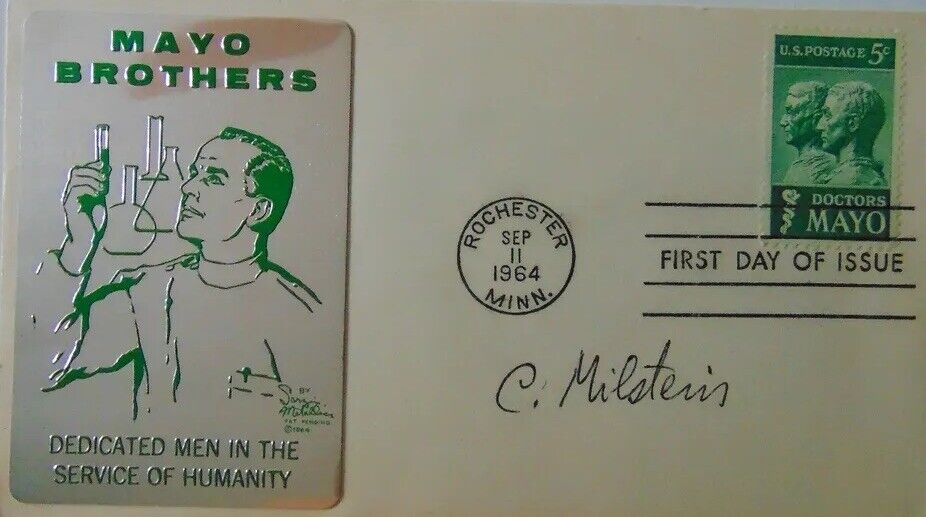RARE "Nobel Prize in Medicine" César Milstein Hand Signed FDC Dated 1964 For Sale

When you click on links to various merchants on this site and make a purchase, this can result in this site earning a commission. Affiliate programs and affiliations include, but are not limited to, the eBay Partner Network.
RARE "Nobel Prize in Medicine" César Milstein Hand Signed FDC Dated 1964:
$499.99
Up for sale a RARE! "Nobel Prize in Medicine" César Milstein FDC Dated 1964.
ES-660A
César Milstein, CH, FRS
(8 October 1927 – 24 March 2002) was an Argentinian
biochemist in the field of antibody research. Milstein shared the Nobel Prize in Physiology or Medicine
in 1984 with Niels Kaj Jerne and Georges J. F. Köhler. Milstein
was born in Bahía Blanca, Argentina. His parents were
Máxima (Vapniarsky) and Lázaro Milstein, a Jewish
Ukrainian immigrant. He graduated from the University of Buenos Aires and obtained a
PhD under Professor Stoppani (Professor of Biochemistry).
Thereafter he was a member of the Medical Research Council Laboratory of
Molecular Biology, Cambridge, England, and held dual Argentine and British
citizenship. In 1956 he received an award from the Sociedad
Bioquímica Argentina for his work on kinetic
studies with the enzyme aldehyde dehydrogenase. In 1958, funded by the British
Council, he joined the Biochemistry
Department at the University of Cambridge at Darwin College to work for a PhD under Malcolm Dixon
on the mechanism of metal activation of the enzyme phosphoglucomutase. During this work he
collaborated with Frederick Sanger whose group he joined with a short-term Medical Research Council appointment. The major part of Milstein's
research career was devoted to studying the structure of antibodies and the
mechanism by which antibody diversity is generated. It was as part of this
quest that in 1975 he, together with Georges
Köhler (a postdoctoral fellow in his laboratory), developed the hybridoma
technique for the production of monoclonal antibodies—a discovery
recognised by the award of the 1984 Nobel Prize for Physiology or
Medicine. This discovery led to an enormous expansion in the
exploitation of antibodies in science and medicine. Milstein himself made many
major contributions to improvements and developments in monoclonal antibody
technology—especially focusing on the use of monoclonal antibodies to provide markers
that allow distinction between different cell types. In collaboration with
Claudio Cuello, Milstein helped lay the foundation for the use of monoclonal
antibodies as probes for the investigation of the pathological pathways in
neurological disorders as well as many other diseases. Milstein and Cuello's
work also enabled the use of monoclonal antibodies to enhance the power of
immuno-based diagnostic tests. In addition Milstein foresaw the potential
wealth of ligand-binding reagents that could result from applying recombinant DNA technology to monoclonal
antibodies and inspired the development of the field of antibody engineering
which was to lead to safer and more powerful monoclonal antibodies for use as
therapeutics. Milstein's early work on antibodies focused on the nature of
their diversity at the amino acid level as well as on the disulphide bonds by
which they were held together. Part of this work was done in collaboration with
his wife, Celia. The emphasis of his research then shifted towards the mRNA
encoding antibodies where he was able to provide the first evidence for the
existence of a precursor for these secreted polypeptides
that contained a signal sequence. The development of the hybridoma
technology coupled to advances in nucleic acid sequencing then allowed Milstein
to chart the changes that occurred in antibodies following antigen encounter.
He demonstrated the importance of somatic hypermutation of immunoglobulin V
genes in antibody affinity maturation. In this process, localised
mutation of the immunoglobulin genes allows the production of improved antibodies
which make a major contribution to protective immunity and immunological
memory. Much of his work in recent years was devoted to characterising this
mutational process with a view to understanding its mechanism and, indeed, he
contributed a manuscript for publication on this topic less than a week before
he died. Quite apart from his own achievements, Milstein acted as a guide and
inspiration to many in the antibody field as well as devoting himself to
assisting science and scientists in less developed countries. It is also worth
mentioning, that even though the Nobel Prize would have made him a wealthy man,
Milstein did not patent his enormous discovery since he believed that it was
mankind's intellectual property. According to his beliefs, his work did not
have any economic interest, only scientific.

Related Items:
RARE "Nobel Prize In Physics" Arthur Schawlow Hand Signed Nobel Biography COA
$399.99
*RARE* "Nobel Prize In Physics" Melvin Schwartz Hand Written Letter COA
$299.99
RARE "Nobel Prize in Medicine" César Milstein Hand Signed FDC Dated 1964
$499.99



